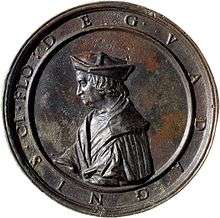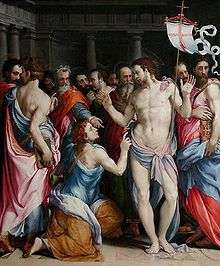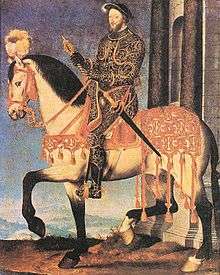Thomas I de Gadagne
Thomas I de Gadagne, known as Thomas the Rich (26 or 27 August 1454, Savoy[1] · [2] - 23 May 1533, Avignon) was a banker from a rich Florentine family who settled in Lyon in France, where he built up trading, banking and industrial business interests in Lyon and Florence. He made a huge fortune and lent large sums to the kings of France to support their military expeditions to Italy and to finance a French expedition to the Americas.

Life
His father brought his three sons (Thomas, François and Olivier) to Lyon in 1434.[3] Thomas grew up in Geneva, where his family also had business interests, before following his family to Florence in 1463. He returned to Lyon in 1468 and became an apprentice in a Florentine banking family, the Pazzi. Thomas also based his own financial business in Lyon and became the richest man in the city.[3] · [1] · [4] His two brothers then his nephews all worked for his company and he was its director until 1527.[5]
He was recognized as the most important spice merchant in the city in 1500 and sixteen years later he appeared in the 'nommées' (fiscal registers estimating the wealth of each of the city's citizens for tax purposes) as the richest inhabitant of the city, taxed on 5000 'livres tournois' - for comparison the next two richest families, the Nasi and Bonvisi, were only taxed on 2500 and 2000 livres tournois respectively.[5] · .[6] When a 'consulat' was imposed on foreign merchants in 1523 to fund work on the city walls, he sent sixty men, compared to thirty required of Robert Albisse, twenty of Pierre Salviati and fifteen of Antoine Gondi. In 1529 the Venetian ambassador Antonio Suriano wrote estimates of each Lyon merchant's wealth - he ranked Thomas at 400,000 ducats.[5] · [7]
Florentine connections

The Florentines in Lyon lived and worked by statutes officially recognized by the Republic of Florence and had to ensure internal harmony in their own community whilst also getting it protection and representation in the city of Florence and the French court. These statutes were established on 27 November 1501, putting the community under the leadership of four counselors and a consul - as the leader of the most important mercantile and banking community in Lyon, the consul more and more had the privilege of leading the payments made at the end of each of the four annual fairs.[5]
Thomas was made a counsellor in 1501 then consul in 1505.[3] · [5] · .[8] He partly paid for the construction of the St Thomas Chapel in Notre-dame de Confort, the Florentine church in Lyon, and his heir and nephew later commissioned a painting for it of The Incredulity of Saint Thomas from Francesco Salviati.[9] He also became a member of the wool guild back in Florence in 1497 and made major investments in Florence, mainly in the commercial and industrial sectors.[10] - for example, he contributed 4000 florins to founding a wool textile factory in 1502 as well as owning a 60% share and sending his brother Olivier and nephew Niccolo Strozzi to manage the factory.[11] Until his death, he remained very active in developing factories in Florence, gaining major commercial success by doing so.[11]
Thomas and the King of France

Citizen of Lyon
Death
He died without issued in 1533 and is buried beside his wife - he left his large fortune to his nephew Thomas II de Gadagne.[3]
Bibliography
- M. Rocke, « The Guadagni of Florence : Family and Society », Medieval and Early Moderne Italy, 1955
- Luigi Passerini, Genealogia e storia della famiglia Guadagni, Florence, Cellini, 1873, 171 p. (notice BnF no FRBNF31064839)
- Georges Yver, De Guadagniis, mercatoribus Florentinis Lugduni, XVI, Paris, Cerf, 1902, 115 p. (notice BnF no FRBNF31677741)
- Richard Gascon, Grand commerce et vie urbaine au seizième siècle : Lyon et ses marchands, Paris & La Haye, Mouton, coll. « École pratique des hautes études. Sixième section. Sciences économiques et sociales. Centre de recherches historiques. Civilisations et sociétés » (no 22), 1971, 2 vol., 1001 p. (notice BnF no FRBNF35371690)
- Marie-Noëlle Baudouin-Matuszek et Pavel Ouvarov, « Banque et pouvoir au XVIe siècle : la surintendance des finances d'Albisse Del Bene », Bibliothèque de l'école des chartes, t. 149-2, 1991, p. 249-291
- Édouard Lejeune, La saga lyonnaise des Gadagne, Lyon, Éditions lyonnaises d'art et d'histoire, 23 mars 2004, 192 p. (ISBN 978-2841471539)
- Michel Francou, Armorial des Florentins à Lyon à la Renaissance, Éditions du Cosmogone, 1er mai 2009 (ISBN 978-2810300204)
- Patrice Béghain, Bruno Benoît, Gérard Corneloup et Bruno Thévenon (coord.), Dictionnaire historique de Lyon, Lyon, Stéphane Bachès, 2009, 1054 p. (ISBN 9782915266658, notice BnF no FRBNF42001687)
References
- (Lejeune 2004, p. 37).
- (Passerini 1873, p. 73).
- (Béghain et al. 2009, p. 529).
- (Baudouin-Matuszek & Ouvarov 1991, p. 252).
- (Lejeune 2004, p. 38).
- (Gascon 1971).
- (Yver 1902, p. 43).
- (Yver 1902, p. 65).
- (Francou 2009, p. 26)
- (Rocke 1955, pp. 55–57).
- (Lejeune 2004, p. 39).